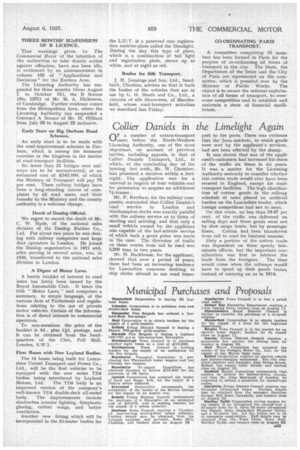Collier Daniels in the Limelight Again
Page 27

If you've noticed an error in this article please click here to report it so we can fix it.
Oy a number of cotton-transport cases before the North-Western Licensing Authority, one of the most important, on account of previous battles, including appeals, is that of Collier Daniels Transport, Ltd., in which, at the concluding day of the hearing, last week; Mr. W. Chamberlain promised a decision within a fortnight. The application was for a renewal in respect of four vehicles and for permission to acquire an additional 5i-tonner.
Mr. P. Kershaw, for the railway companies, contended that Collier Daniels's road service to London and Southampton docks was exactly parallel with the railway service as to times of starting and arriving, and that only a small vehicle owned by the applicant was capable of the last-minute service of which such a great point was made in the case. The diversion of traffic on these routes from rail to road was 3,200 tons in two years.
Mr. H. Backhouse, for the applicant, showed that over a period of years, there had teen an increasing tendency for Lancashire concerns desiring to ship cloths abroad to use road trans port to the ports. There was evidence that the Java markets, to which goods were sent by the applicant's services. had not been affected by the slump.
It was shown that one of the applicant's customers had increased his share of the traffic six times in six years. It was a matter for the Licensing Authority seriously to consider whether this cotton trade would ever have been secured in England, except for roadtransport facilities. The high classification of cotton goods in the railway schedule of rates placed an artificial burden on the Lancashire trader, which foreign competitors had not to meet.
On this route, no less than 38-47 per cent. of the traffic was delivered on sailing days and these goods went not by slow cargo boats, but by passenger liners. Cotton bad, been transferred from rail to road for business reasons.
Only a portion of the cotton trade was dependent on these speedy lastminute efforts, but the important consideration was first to retrieve the trade from the foreigner. The time would come when the railways would have to speed up their goods trains, instead of carrying on as in 1914.












































































